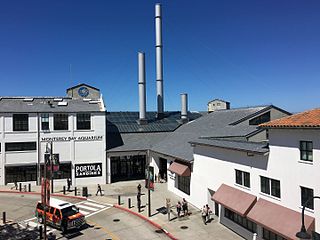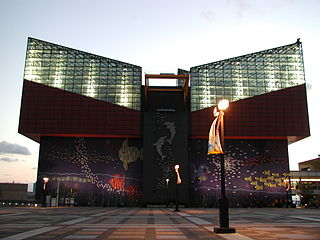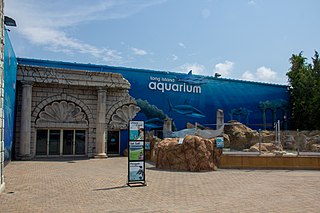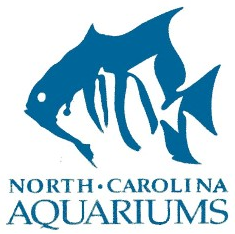History
The "Maritime Center" opened July 16, 1988. The name was changed to the "Maritime Aquarium" in July 1996 to emphasize the live animals featured there.
It first opened by renovating a former 1860s iron works factory into an IMAX theater. Visitors, as they walk past the Ray Touch Pool toward the Marine Lab, still tread on the original wood floors (under original wood beams) of the iron works. Occupying approximately 100,000 gross square feet, the first animal exhibits included harbor seals, Open Ocean and Touch Tank.
The cultural section of the aquarium originally explored boat building and human exploration of the sea, but the boatbuilding activities were eliminated in early 2007. In the final seven years of its 19-year run, the boatbuilding program constructed about 500 boats, and 20,000 children took part in classes that created more than 5,000 model boats, but aquarium officials said the shop only served three to five percent of patrons. [3]
The boatbuilding shop was replaced with a new Marine Lab, with baby seahorses, jellyfish, and other new animals, as well as information on aquaculture, sustainable seafood, and responsible home aquarium keeping.
- 1991: Exhibit space is expanded by adding the 7,000-square-foot (650 m2) "Featured Exhibits" area, a semi-permanent fabric and steel structure. The first exhibit is Real Sea Monsters, featuring extinct sea creatures like Kronosaurus and Megalodon.
- 1994: Outdoor exhibit space, including bleachers, is added along the Norwalk River for summertime exhibits and shows. It opens with a bird-of-prey show.
- 1995: Jellyfish Encounter opens. Aquarium curators solve significant challenges to display these delicate animals that are approximately 95% water.
- 1996: The Maritime Center changes its name to The Maritime Aquarium at Norwalk, to better identify itself to the public and underscore the increasing importance of live animal exhibits. River Otters and Ray Touch Pool open.
- 2001: The aquarium expands into the Hatch and Bailey factory building, converting and rehabilitating 33,000 square feet (3,100 m2) of space into a new, $9.5 million Environmental Education Center (funded through corporate, private and state contributions). New space allows a reconfiguring of the existing aquarium:
- Giant Sea Turtles opens, including a 15,000-gallon habitat, interpretive signs, and turtle shell photo opportunity.
- A new main entrance improves visitor reception and admission.
- New Oyster Hall (group orientation space and lunchroom) opens just off of the main entrance, which allow for staging and organizing busloads of visiting students.
- New high-tech classrooms (with multimedia and wet lab facilities) are added, as are teachers' rooms, to expand the Maritime Aquarium's educational programs.
- Cascade Cafe opens with seating for 180 people.
- Gift shop moves and expands.
- 2006: Touch Tank is moved and greatly enhanced, creating a more natural display, allowing animals to live "on-site" and offering better access to visitors. The aquarium's volunteer staff funds reconstruction.
- 2007: Frogs! opens, a new permanent exhibit displaying amphibians from Long Island Sound's shores and watershed, as well as exotic species from around the world, to draw attention to the importance of amphibians as bellwether species for environmental change. The small boat building shop is closed.
- 2008: During the summer, the Great White Alligator is displayed in the outdoor exhibit space.
- 2009: African Penguins temporary outdoor exhibit opens.
- 2010: Temporary Meerkat Exhibit opens.
- 2012: FINtastic RefurbFISHment is unveiled with new sea life and hands-on-exhibits. [4] The white alligator also returned to the aquarium for the summer.
In recent years, the Maritime Aquarium has emphasized helping visitors understand the ecology of Long Island Sound and its watershed. The aquarium participates in and directs local scientific research on Long Island Sound's animal residents, including a counting and tagging program for horseshoe crab and annual counts of harbor seal. The Maritime Aquarium also helped create the Long Island Sound Biodiversity Database, which is open to the public.
In 2006, the aquarium became a partner with SeafoodWatch, a program that encourages consumers to make responsible seafood choices that have a low impact on the environment and promote sustainable fisheries.
In February 2021, the aquarium replaced its now closed IMAX theatre with a new 4-D movie theatre. [5]

Monterey Bay Aquarium is a nonprofit public aquarium in Monterey, California. Known for its regional focus on the marine habitats of Monterey Bay, it was the first to exhibit a living kelp forest when it opened in October 1984. Its biologists have pioneered the animal husbandry of jellyfish and it was the first to successfully care for and display a great white shark. The organization's research and conservation efforts also focus on sea otters, various birds, and tunas. Seafood Watch, a sustainable seafood advisory list published by the aquarium beginning in 1999, has influenced the discussion surrounding sustainable seafood. The aquarium is the home of the current oldest living sea otter, Rosa, and the birthplace of Otter 841.

The National Aquarium – also known as National Aquarium in Baltimore and formerly known as Baltimore Aquarium – is a non-profit public aquarium located at 501 East Pratt Street on Pier 3 in the Inner Harbor area of downtown Baltimore, Maryland in the United States. Constructed during a period of urban renewal in Baltimore, the aquarium opened on August 8, 1981. The aquarium has an annual attendance of 1.5 million visitors and is the largest tourism attraction in the State of Maryland. The aquarium holds more than 2,200,000 US gallons (8,300,000 L) of water, and has more than 17,000 specimens representing over 750 species. The National Aquarium's mission is to inspire conservation of the world's aquatic treasures. The aquarium's stated vision is to confront pressing issues facing global aquatic habitats through pioneering science, conservation, and educational programming.

The Osaka Aquarium Kaiyukan is an aquarium located in the ward of Minato in Osaka, Osaka Prefecture, Japan, near Osaka Bay. When it first opened, it was the largest public aquarium in the world. It is a member of the Japanese Association of Zoos and Aquariums.

Shedd Aquarium is an indoor public aquarium in Chicago. Opened on May 30, 1930, the 5 million US gal aquarium holds about 32,000 animals and is the third largest aquarium in the Western Hemisphere, after the Georgia Aquarium and Monterey Bay Aquarium.

The Oregon Coast Aquarium is an aquarium in Newport in the U.S. state of Oregon. Opened in 1992, the facility sits on 23 acres (9.3 ha) along Yaquina Bay near the Pacific Ocean. The aquarium was home to Keiko, the orca who starred in the movie Free Willy, from January 7, 1996 until September 9, 1998, when he was shipped to Vestmannaeyjar, Iceland. USA Today considers the Oregon Coast Aquarium world-class and Coastal Living magazine ranks it among the top ten aquariums in North America.

The Vancouver Aquarium is a public aquarium located in Stanley Park in Vancouver, British Columbia, Canada. In addition to being a major tourist attraction for Vancouver, the aquarium is a centre for marine research, ocean literacy education, climate activism, conservation and marine animal rehabilitation.

The New England Aquarium is a nonprofit organization located in Boston, Massachusetts. The species exhibited include harbor and northern fur seals, California sea lions, African and southern rockhopper penguins, giant Pacific octopuses, weedy seadragons, and thousands of saltwater and freshwater fishes. In addition to the main aquarium building, attractions at Central Wharf include the Simons Theatre and the New England Aquarium Whale Watch. More than 1.3 million guests visited the aquarium each year prior to the outbreak of the COVID-19 pandemic.

The Aquarium of the Pacific is a public aquarium on a 5-acre (20,000 m2) site on Rainbow Harbor in Long Beach, California, United States. It is situated across the water from the Long Beach Convention Center, Shoreline Village, and the Queen Mary Hotel and Attraction.

Sea Life Sunshine Coast at Mooloolaba, Sunshine Coast, Queensland, Australia is a marine mammal park, oceanarium and wildlife sanctuary. Sea Life Sunshine Coast is an institutional member of the Zoo and Aquarium Association (ZAA). The attraction is a Sea Life Centre owned by Merlin Entertainments, and is globally referred to as Sea Life Sunshine Coast by the firm. It was formerly known as UnderWater World.

The Alaska SeaLife Center, Alaska's premier public aquarium and Alaska's only permanent marine mammal rehabilitation facility, is located on the shores of Resurrection Bay in Seward in the U.S. state of Alaska. Open since May 1998, it is dedicated to understanding and maintaining the integrity of the marine ecosystem of Alaska through research, rehabilitation, conservation, and public education. It is the only facility in the world specifically dedicated to studying the northern marine environment and the only one designed at the outset to combine research with public education and visitor components. The Alaska SeaLife Center generates and shares scientific knowledge to promote understanding and stewardship of Alaska's marine ecosystems.

The ABQ BioPark Aquarium, located in Albuquerque, New Mexico, United States is a facility of the Albuquerque Biological Park and is located next door to the ABQ BioPark Botanic Garden. The ABQ BioPark Aquarium exhibits Gulf of Mexico and South Pacific saltwater species from a variety of habitats, including surf zone, shallow waters, coral reefs, open ocean and deep ocean. The highlight of the aquarium is a 285,000 U.S. gal (1,080,000 L) shark tank with a 38-foot (12 m)-wide, 9-foot (2.7 m)-high, 8-inch (200 mm)-thick acrylic viewing window. The South Pacific Gallery features seahorses, pipefishes, and colorfully patterned reef fish. The Rio Grande at Central Bridge exhibit in the aquarium lobby offers visitors an opportunity to compare the kinds of fish that lived in the Albuquerque reach of the Rio Grande 100 years ago and those found today. The Shark/Ray Encounter allows guests to have a guided, up-close experience with bamboo sharks and stingrays.

The Great Lakes Aquarium opened in 2000 and is located on the Duluth waterfront. A 501(c)(3) private nonprofit, Great Lakes Aquarium features animals and habitats found within the Great Lakes basin and other freshwater ecosystems such as the Amazon River. The Aquarium houses 205 different species of fish, birds, reptiles, amphibians, and mammals. It is one of few aquariums in the United States that focuses predominantly on freshwater exhibits.

The South Carolina Aquarium, located in Charleston, South Carolina, opened on May 19, 2000, on the historic Charleston Harbor in the former location of the Anson Borough Homes, a public housing project that was closed over soil contamination and flooding conerns. It is home to more than ten thousand plants and animals including North American river otters, loggerhead sea turtles, alligators, great blue herons, owls, lined seahorses, jellyfish, pufferfish, green moray eels, horseshoe crabs, sea stars, pythons, and sharks. The largest exhibit in the zoo is the Great Ocean Tank, which extends from the first to the third floor of the Aquarium and is the deepest tank in North America ; it holds more than 385,000 US gallons (1,460,000 L) of water and contains more than 700 animals. The Aquarium also features a Touch Tank, where patrons may touch horseshoe crabs, Atlantic stingrays, and other marine animals.
SEA LIFE Sydney Aquarium is a public aquarium that features a large variety of Australian aquatic life, displaying more than 700 species comprising more than 13,000 individual fish and other sea and water creatures from most of Australia's water habitats. Opened in 1988, it is regarded as one of Sydney's premier tourist attractions with over 55% of its visitors each year coming from overseas.
Mystic Aquarium is a marine aquarium in Mystic, Connecticut. It is one of only two U.S. facilities holding Steller sea lions, and it has the only beluga whales in New England. Special exhibits include the largest outdoor beluga whale habitat in the United States, a ray and shark touch pool, an African penguin exhibit, a jelly gallery, and the new Dino Seas: An Immersive Journey exhibit. The aquarium is a member of the Alliance of Marine Mammal Parks and Aquariums (AMMPA) and is an accredited member of the Association of Zoos and Aquariums (AZA). It is a subsidiary of the Sea Research Foundation, Inc.

The Texas State Aquarium is a nonprofit aquarium located in Corpus Christi, Texas, United States. It aims to promote environmental conservation and rehabilitation of the wildlife of the Gulf of Mexico. It has been accredited by the Association of Zoos and Aquariums (AZA) since 1995. It is the largest aquarium in Texas and one of the largest aquaria in the United States.

The Virginia Aquarium & Marine Science Center, formerly known as the Virginia Marine Science Museum, is an aquarium and marine science museum located in Virginia Beach, Virginia, just south of Rudee Inlet. The exhibits at the museum are contained in over 800,000 US gallons (3,028,000 L) of fresh and saltwater displays.

Long Island Aquarium is an aquarium that opened in 2000 on Long Island in Riverhead, New York, United States.

North Carolina Aquariums is a system of three public aquariums located in Kure Beach, Roanoke Island and Pine Knoll Shores. All are operated by the Aquariums Division of the North Carolina Department of Natural and Cultural Resources since 1976 and were accredited by the Association of Zoos and Aquariums. All three aquariums feature dive shows, live animal encounters, and feeding programs.

The Adventure Aquarium, formerly the Thomas H. Kean New Jersey State Aquarium, is a for-profit educational entertainment attraction operated in Camden, New Jersey on the Delaware River Camden Waterfront by Herschend Family Entertainment. Originally opened in 1992, it re-opened in its current form on May 25, 2005 featuring about 8,000 animals living in varied forms of semi-aquatic, freshwater, and marine habitats. The facility has a total tank volume of over 2 million US gallons (7,600,000 L), and public floor space of 200,000 square feet (19,000 m2).






















